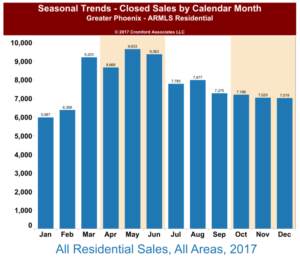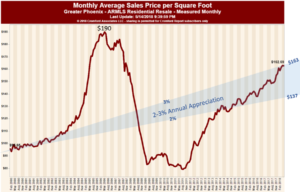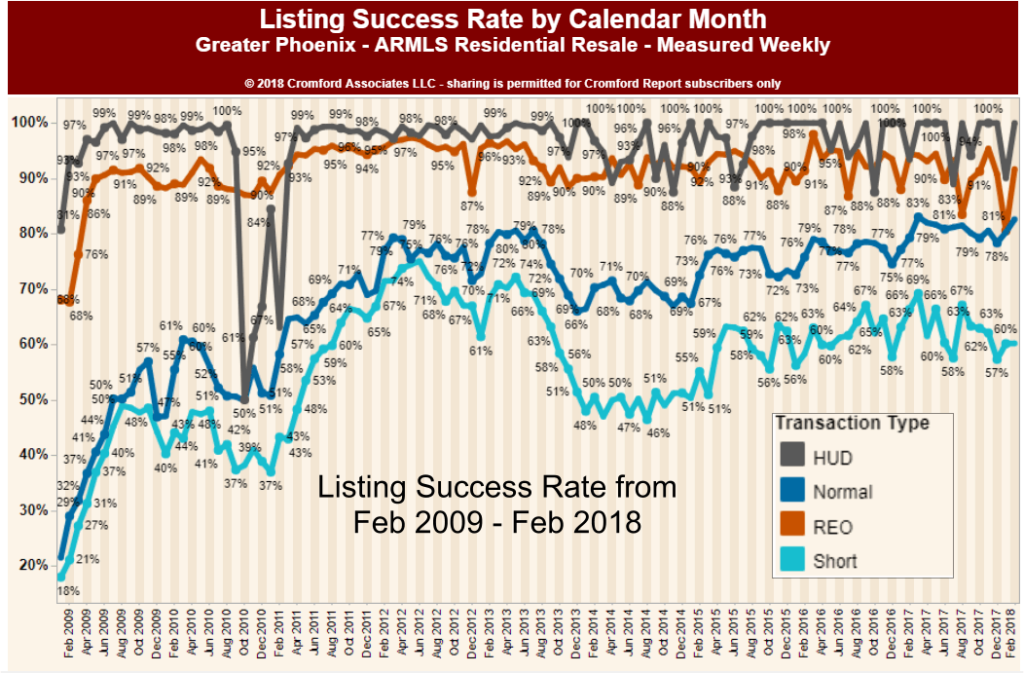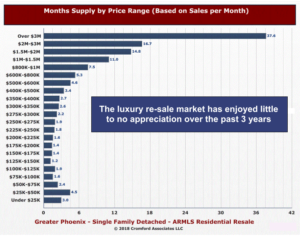Recently national housing statistics have made headlines regarding the diminishing demand of homebuyers. This is understandably unsettling to homeowners in the valley who recall all too  well the housing crises where supply and demand went topsy turvey. As interesting as it may be to listen to national housing statistics, they are generally antidotal. Even in the midst of the housing crisis of the “Great Recession” there were markets that saw little downturn – proving that real estate markets are local. Is the valley in the midst of dwindling demand? The short answer – a slight abating of demand is possibly underway. Is it so great to affect pricing or cause any significant impact to our market? No. This is due to the largely chronic lack of supply. Perhaps some numbers can better put this in perspective.
well the housing crises where supply and demand went topsy turvey. As interesting as it may be to listen to national housing statistics, they are generally antidotal. Even in the midst of the housing crisis of the “Great Recession” there were markets that saw little downturn – proving that real estate markets are local. Is the valley in the midst of dwindling demand? The short answer – a slight abating of demand is possibly underway. Is it so great to affect pricing or cause any significant impact to our market? No. This is due to the largely chronic lack of supply. Perhaps some numbers can better put this in perspective.
Demand The first thing to understand is the seasonality component of real estate – i.e. different times of the year perform differently. Headlines can rather easily claim “buyer demand is down” simply by comparing April’s numbers to September’s numbers. Buyer activity reaches its peak in April and then increasingly slows through the rest of the year. To have meaningful comparisons year over year numbers should be examined. One key measurement of buyer demand is contracts. We can then see for instance, that contracts have dropped 26% from the April peak this year, compared to a 20% drop in 2017 over the same time period. That can lead us to the conclusion that a slight weakening in demand may be underway. Slight being the keynote concept.
Supply Like demand, supply also follows a seasonal pattern. Listings typically hit their low point in August and then rise until Thanksgiving (with a large exodus of cancelling listings at the end of the year). In 2018 we hit the low point a bit early – July – and supply has been drifting upwards since. But before we hit the alarm button, the overall numbers put this in perspective. Here is an interesting analysis made in June of this year by the Cromford Report :
The total number of active listings … is 19,736 today for all areas & types across the ARMLS database. This is just slightly above June 15, 2011 when we saw 19,696. We have to go all the way back to October 2005 to find another 15th date (19,715) with lower active listings.
Active listing counts have been on a declining trend since April 2014 when we hit a short term peak of 30, 506. We would consider somewhere between 30,000 and 35,000 to be sufficient for a balanced market. The all-time record high for a 15th date is 58,195 in November 2007.
Between 30,000-35,000 active listings would be considered a balanced market. As of this writing the active listing count is at 19,860 – not even close to a balanced market (and remember, that even balanced markets do not cause price drops – they just stop or slow appreciation).
Of course, different areas and types of properties are reacting differently on supply levels. As Cromford comments:
There are some areas that have seen a dramatic rise, often from abnormally low levels. Florence is probably the best example. At the end of June we had just 100 active listings without a contract, but since then the count has shot up 38%. The trend does not affect mobile homes, but single-family listings have jumped from 71 to 111, an increase of 56% in just 8 weeks. A similar but smaller event has occurred in Casa Grande and Coolidge. The only areas outside of Pinal County with a jump like this (albeit more moderate) are Litchfield Park and Surprise.
The Answer -So what is the take away of all this? If demand is showing early signs of lessening, and some areas are seeing increasing supply – when is the tipping point? The answer is contained in the supply numbers. Again, to quote Cromford :
Fluctuations in demand are unlikely to have much impact on the market until we see an increasing trend in listing counts. This was the first sign of a slowdown in April 2005 and will be the first sign of a slowdown if and when we get one in the future. It came suddenly and unexpectedly in April 2005 and it may do the same at any time. However, nobody paid any attention in 2005 and I am assuming we are all older and wiser now. Any unusual activity in the listing counts will show up in the daily Tableau charts which we create and study each and every day.
We too watch the listing counts. When we see shifts, you will hear it from us. Until then, do not believe the headlines. As always, we are here to help you with any questions or concerns specific to your home or neighborhood.
Russell & Wendy Shaw
(Mostly Wendy)


 commented in the past that we are not in a “bubble”. But a recent commentary by the Cromford Report on pricing really caught our eye. It is not surprising to us that the press routinely shares erroneous housing market information often using statistics to make a poorly examined point. Homeowners would be well advised to have a skeptic’s heart when accepting the media’s research. As British Prime Minister Benjamin Disraeli so famously said (and Mark Twain popularized) “There are three kinds of lies: lies, damned lies, and statistics.” The latest premise is that housing prices have exceeded the prices set in the 2006 market. Uh… not exactly. As no one says it better than our guru Michael Orr of the Cromford Report, here are his comments (with only bolding by us for emphasis) that explain the facts about the housing numbers:
commented in the past that we are not in a “bubble”. But a recent commentary by the Cromford Report on pricing really caught our eye. It is not surprising to us that the press routinely shares erroneous housing market information often using statistics to make a poorly examined point. Homeowners would be well advised to have a skeptic’s heart when accepting the media’s research. As British Prime Minister Benjamin Disraeli so famously said (and Mark Twain popularized) “There are three kinds of lies: lies, damned lies, and statistics.” The latest premise is that housing prices have exceeded the prices set in the 2006 market. Uh… not exactly. As no one says it better than our guru Michael Orr of the Cromford Report, here are his comments (with only bolding by us for emphasis) that explain the facts about the housing numbers:
 know them. She came to the shelter with her two siblings, Tanman and Louise. Yes, all three of them are still looking for homes. Thelma is very cat social, she is most comfortable when she has feline buddies to pal around with. The perfect home for Thelma will have existing cats for her to play and lounge about with. If you are really looking to make Thelma happy, you could adopt her and her siblings. Home Fur Good is located at 10220 N. 32nd Street in Phoenix. The shelter is open Thursday, Friday and Saturday from 11-4. You can call HFG at 602-971-1334. Visit the website at
know them. She came to the shelter with her two siblings, Tanman and Louise. Yes, all three of them are still looking for homes. Thelma is very cat social, she is most comfortable when she has feline buddies to pal around with. The perfect home for Thelma will have existing cats for her to play and lounge about with. If you are really looking to make Thelma happy, you could adopt her and her siblings. Home Fur Good is located at 10220 N. 32nd Street in Phoenix. The shelter is open Thursday, Friday and Saturday from 11-4. You can call HFG at 602-971-1334. Visit the website at  been area specific, so while national trends are interesting, they are not particularly meaningful when interpreting a local market. New listings to MLS in the first quarter of 2018 for Maricopa and Pinal County under 400K are logging the lowest numbers for a first quarter since the Cromford Report began tracking in 2001. Not surprisingly given the low supply, appreciation is higher than it’s been in the last several years. To quote the Cromford Report:
been area specific, so while national trends are interesting, they are not particularly meaningful when interpreting a local market. New listings to MLS in the first quarter of 2018 for Maricopa and Pinal County under 400K are logging the lowest numbers for a first quarter since the Cromford Report began tracking in 2001. Not surprisingly given the low supply, appreciation is higher than it’s been in the last several years. To quote the Cromford Report: motivated and aims to please, so training comes easily. Brooklyn loves to hike and has started her own peak bagging list. She is dog selective, enjoying larger dogs that like to rough house. Brooklyn would be happy in a family with one parent or one full of kids, she only wants to be an active member. Home Fur Good is located at 10220 N. 32nd Street in Phoenix. The shelter is open Thursday, Friday and Saturday from 11-4. You can call HFG at 602-971-1334. Visit the website at
motivated and aims to please, so training comes easily. Brooklyn loves to hike and has started her own peak bagging list. She is dog selective, enjoying larger dogs that like to rough house. Brooklyn would be happy in a family with one parent or one full of kids, she only wants to be an active member. Home Fur Good is located at 10220 N. 32nd Street in Phoenix. The shelter is open Thursday, Friday and Saturday from 11-4. You can call HFG at 602-971-1334. Visit the website at  as inventory is rapidly evaporating in the low price points just like in 2005. But is this really “just like 2005”? No it really isn’t. For good or bad we have been through a number of real estate cycles (Russell entered real estate in 1978 and Wendy in 1982) so it is natural to compare the present with the past. But memory is often faulty and I think she is forgetting the real roller coaster ride of 2005. A couple of facts pulled from the Cromford Report archives for 2005 numbers vs. today’s number illustrate the point:
as inventory is rapidly evaporating in the low price points just like in 2005. But is this really “just like 2005”? No it really isn’t. For good or bad we have been through a number of real estate cycles (Russell entered real estate in 1978 and Wendy in 1982) so it is natural to compare the present with the past. But memory is often faulty and I think she is forgetting the real roller coaster ride of 2005. A couple of facts pulled from the Cromford Report archives for 2005 numbers vs. today’s number illustrate the point: homes under 200K seem to be the wooly mammoth quickly headed for extinction. Understandably entry level buyers and their agents are bemoaning the lack of inventory in that coveted price range. Perhaps there is a need for a bit of a reality check. Phoenix is the 5th largest city in the US. The rankings currently are:
homes under 200K seem to be the wooly mammoth quickly headed for extinction. Understandably entry level buyers and their agents are bemoaning the lack of inventory in that coveted price range. Perhaps there is a need for a bit of a reality check. Phoenix is the 5th largest city in the US. The rankings currently are: she will entertain herself while putting on a show for you. Kimmie also does her best to make friends with the other cats and kittens at the shelter. Come down to Home Fur Good at 10220 N. 32nd Street in Phoenix. The Free Roaming Cat Room is open for adoptions Thursday, Friday and Saturday from 11am – 4pm. You can also call at 602-971-1334.
she will entertain herself while putting on a show for you. Kimmie also does her best to make friends with the other cats and kittens at the shelter. Come down to Home Fur Good at 10220 N. 32nd Street in Phoenix. The Free Roaming Cat Room is open for adoptions Thursday, Friday and Saturday from 11am – 4pm. You can also call at 602-971-1334.